12.05.2023
Chinese cargo ship launches to resupply space station
Updated after docking of Tianzhou 6 with the Tiangong space station.
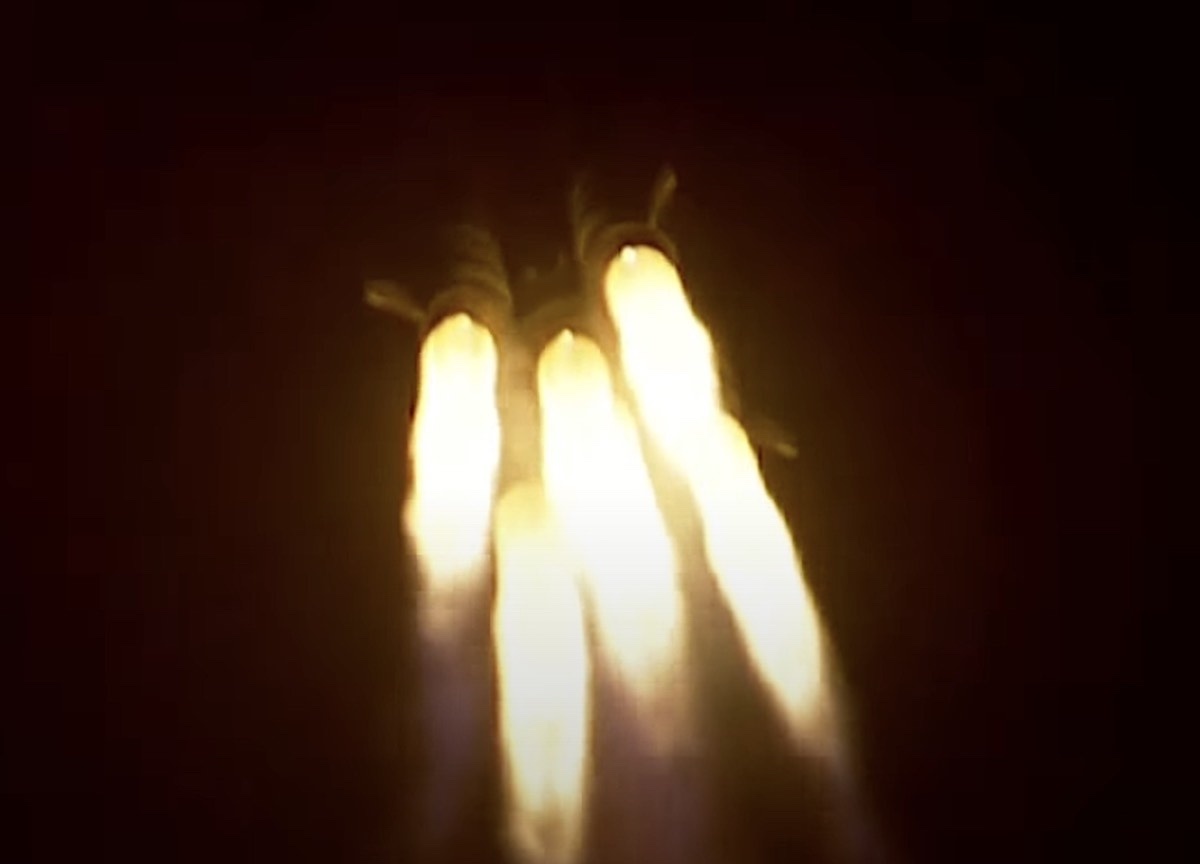
China’s space station received delivery of fresh supplies, experiments, and fuel after the launch of the Tianzhou 6 cargo ship Wednesday aboard a Long March 7 rocket.
The unpiloted supply freighter automatically docked with China’s Tiangong space station at 5:16 p.m. EDT (2116 UTC) Wednesday. Three Chinese astronauts aboard the orbiting outpost will open hatches and begin unpacking equipment, while internal valves open to flow propellants from the cargo ship into storage tanks on the station’s Tianhe core module.
The Tianzhou 6 spacecraft debuts an upgraded internal design, with 20% more payload capacity to carry up to 7.4 metric tons (16,300 pounds) of cargo. The cargo ship also carries about 1,750 kilograms (3,858 pounds) of propellant to support the space station, about 700 kilograms (1,543 pounds) of which will refill tanks on the Tiangong space station.
The modifications to Tianzhou 6 are primarily inside the spacecraft to improve the packing efficiency of the pressurized cargo module. The spacecraft weighed nearly 30,000 pounds (about 13.5 metric tons) at launch, the same as previous Tianzhou missions.
The resupply mission lifted off on a 174-foot-tall (53-meter) Long March 7 rocket from the Wenchang launch base on Hainan Island, China’s newest and southernmost spaceport. The exact liftoff time of 9:22:51 a.m. EDT (1322:51 UTC) Wednesday was set to coincide with the moment Earth’s rotation carried the launch pad under the flight path of the Tiangong space station, enabling a quick rendezvous and docking.
The Tiangong space station, with its three-person crew, orbits more than 230 miles (370 kilometers) above Earth at an inclination of 41.5 degrees to the equator. Tianzhou 6 is the sixth flight of China’s resupply ship, which is similar in purpose to the SpaceX Dragon, Northrop Grumman Cygnus, and Russian Progress cargo ships that regularly deliver equipment to the International Space Station.
It’s the fifth Tianzhou mission to the Tiangong space station, following a test flight to China’s now-decommissioned Tiangong 2 space lab, a testbed used before construction of the larger Tiangong complex. Tianzhou means “heavenly ship” in English.
The Long March 7 rocket ignited six booster engines to climb off the launch pad at Wenchang with 1.6 million pounds of thrust. An on-board guidance computer commanded the rocket to head southeast over the South China Sea, lining up with the Tiangong space station’s orbit.
The Long March 7 is a two-stage rocket augmented with four strap-on boosters. The rocket consumed 45,000 gallons, or 170 cubic meters, of kerosene fuel in combination with cryogenic liquid oxygen during the 10-minute ascent into orbit.

After separating from the Long March 7’s second stage, the Tianzhou 6 spacecraft deployed solar arrays and started firing thrusters to fine-tune its approach for docking at the Tiangong space station.
Clothing and food, including fresh fruit, for the Tiangong space station crew are packed aboard the Tianzhou 6 spacecraft. The mission delivered equipment to support 29 scientific experiments, according to China’s Manned Space Agency.
The Tianzhou 6 mission is the first resupply flight to the space station since China completed assembly of the Tiangong outpost. With construction complete, the Tiangong station needs less propellant for in-orbit maneuvers, so Chinese space officials shifted the cargo load for Tianzhou 6 from an emphasis on propellant to a focus on dry goods.
The fuel on Tianzhou 6 to be transferred inside the space station include xenon gas for the Tiangong lab’s electric propulsion system.
At the end of the Tianzhou 6 mission, Chinese astronauts will pack trash into the cargo spacecraft for disposal during a fiery re-entry back into the atmosphere. While docked to the Tiangong station, Tianzhou cargo ships can provide propulsion to change the orbit of the complex.
Launch of the space station’s next three-person crew is scheduled later this month on China’s Shenzhou 16 mission, followed soon after by the return to Earth of the Shenzhou 15 crew, which has been living and working on the Tiangong complex since November.
Quelle: SN
+++
Tianzhou-6 cargo spacecraft reaches China’s Tiangong space station
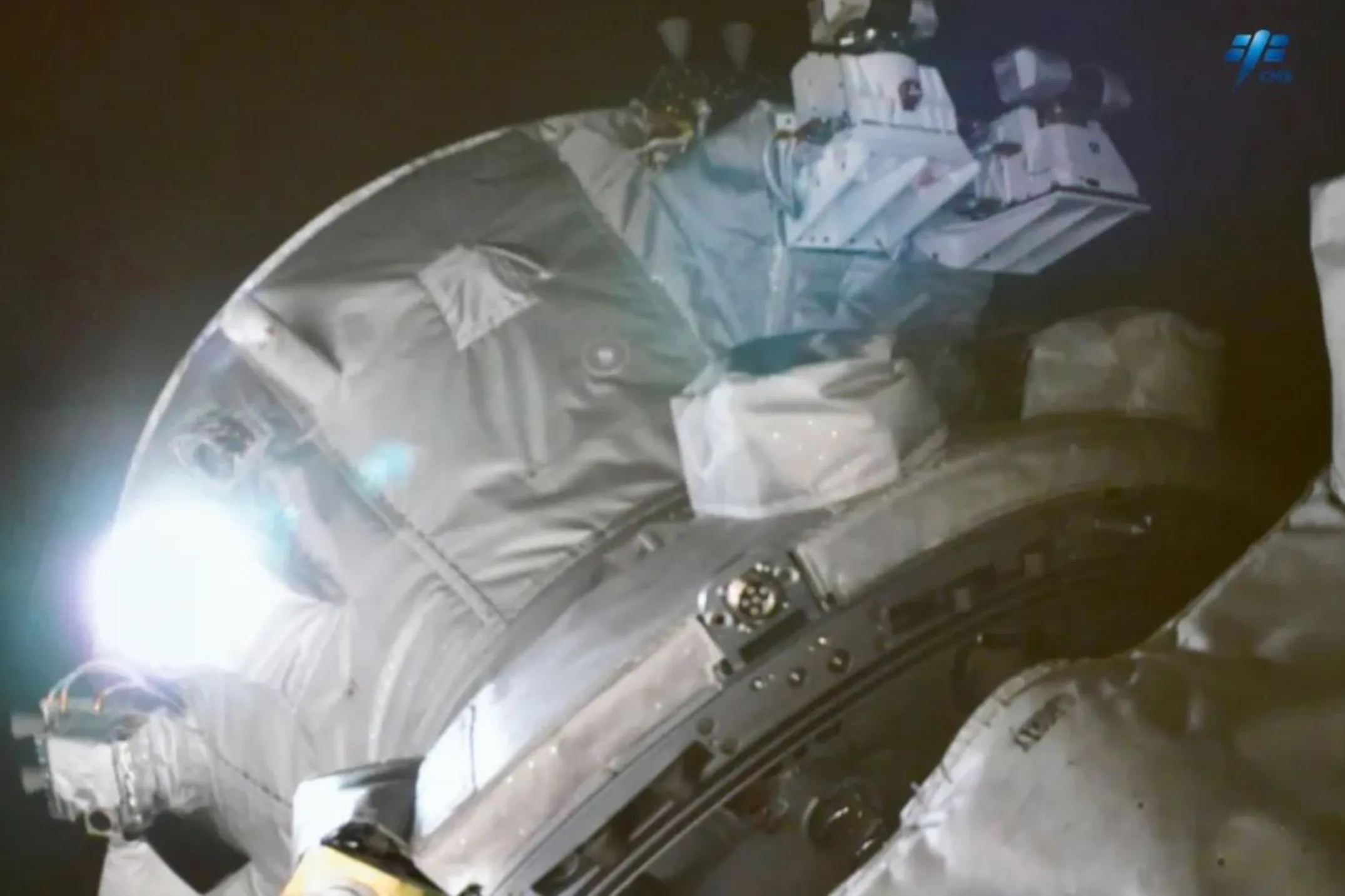
The Tianzhou-6 cargo spacecraft docks at Tiangong on May 10, 2023. Credit: CMSA
HELSINKI — An upgraded Tianzhou cargo spacecraft docked at China’s Tiangong space station Wednesday ahead of a new crewed mission to the orbital outpost.
A Long March 7 rocket lifted off from the coastal Wenchang Satellite Launch Center at 9:22 a.m. Eastern, May 10. The rocket inserted the Tianzhou-6 spacecraft into its planned low Earth orbit around 20 minutes later.
Docking at the Tiangong space station’s aft docking port occurred at 5:16 p.m., completing the rendezvous and docking process nearly eight hours after launch, according to China’s human spaceflight agency.
The Tianzhou-6 spacecraft carries supplies for astronauts, science payloads and propellant for the space station and features improvements over the previous five spacecraft. Its pressurized volume has been increased by 20 percent, from 18.1 to 22.5 cubic meters, with its cargo capacity rising to 7.4 tons, up from 6.9 tons. The spacecraft’s mass at liftoff has also increased by 500 kilograms to around 14 tons.
Tianzhou-6 carries supplies to last a crew of three for 280 days. Also aboard are 714 kilograms of science experiments in the areas of space life science and biotechnology, microgravity fluid physics and combustion science, space material science, and space application technology tests, Lv Congmin, deputy chief designer of the Tiangong’s application system, told CCTV.
A further 160 kilograms are dedicated xenon ion thruster components, according to the China Aerospace Science and Technology Corporation (CASC), China’s main space contractor. Tianzhou-6 also carries 1.7 tons of propellant, of which 700 kilograms will be transferred to Tiangong for maintaining its orbit.
China completed construction of the three-module Tiangong in late 2022. Tianzhou-6 is the first mission of the operational phase of Tiangong. The country aims to keep the station permanently occupied for at least a decade, with crews of the three astronauts spending six months aboard at a time.
The Tianzhou-5 cargo spacecraft, launched in November 2022, undocked from Tiangong on May 5, making way for the arrival of Tianzhou-6. Tianzhou-5 will dock at Tiangong’s forward port following the departure of the Shenzhou-15 spacecraft later this month.
The Shenzhou-15 crew have almost completed their six-month-long mission and will greet the Shenzhou-16 astronauts aboard Tiangong in the new future. Shenzhou-16 will launch from Jiuquan in the Gobi Desert on a Long March 2F in coming weeks, according to earlier schedules.
The expansion in capacity of Tianzhou-6 means China will need to launch a Tianzhou mission once every eight months, instead of every six months, as previously.
The flight was the seventh of the 53.1-meters-long Long March 7, which was designed specifically to launch Tianzhou cargo spacecraft. A variant with an added third stage is used for missions to geostationary transfer orbit.
The rocket was provided by the China Academy of Launch Vehicle Technology (CALT), while the spacecraft was designed and manufactured by the China Academy of Space Technology (CAST). Both are major entities under the aegis of CASC.
CASC aims to launch a national record of more than 60 orbital flights in 2023. CASC is also working on expanding Tiangong with a “multi-functional module.” The module would allow China to further expand the size of the space station and enhance its capacity, according to officials.
Quelle: SN
+++
China Focus: China launches new cargo mission to space station
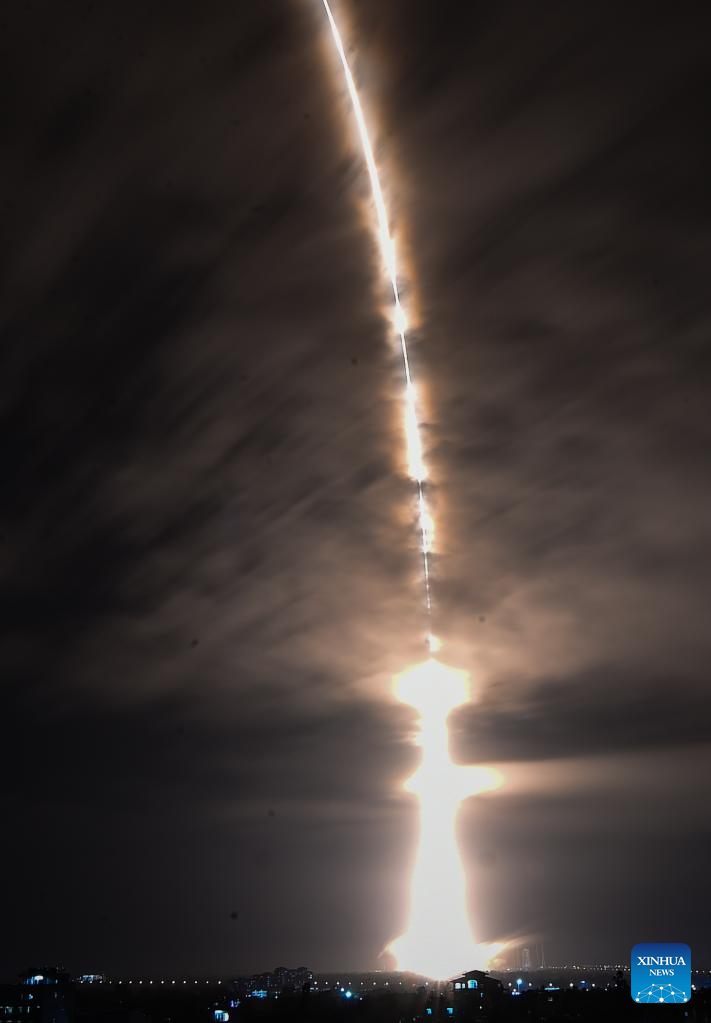
A Long March-7 Y7 rocket carrying the Tianzhou-6 cargo craft blasts off from the Wenchang Spacecraft Launch Site in south China's Hainan Province, May 10, 2023. (Xinhua/Yang Guanyu)
China launched a new cargo mission on Wednesday night to transport supplies to its orbiting Tiangong space station, according to the China Manned Space Agency.
Carrying the Tianzhou-6 cargo craft, a Long March-7 Y7 rocket lifted off at 9:22 p.m. (Beijing Time) from the Wenchang Spacecraft Launch Site in the southern island province of Hainan, the agency said.
After around 10 minutes, Tianzhou-6 separated from the rocket and entered its designated orbit. Its solar panels soon unfolded and began working. The agency declared the launch a complete success.
The cargo vessel will later conduct an automated rendezvous and docking with the station combination in orbit.
The newly launched Tianzhou-6 has improved features compared to the previous Tianzhou craft, with a greater loading volume and a larger carrying capacity.
Wang Ran, chief designer of the Tianzhou series who works with the China Academy of Space Technology, said the effective loading volume increased from 18.1 cubic meters to 22.5 cubic meters, equivalent to a 20 percent expansion. The loading capacity has been improved to 7.4 tonnes, making Tianzhou-6 the world's largest cargo spacecraft in service.
In this mission, Tianzhou-6 is loaded with more than 200 pieces of goods, including daily supplies for taikonauts as well as clothes, food, fruit and water, with a total weight of around 5.8 tonnes.
The cargo craft has also upgraded to reduce the launch demand for cargo craft from twice a year to three times every two years, which will substantially reduce transportation costs.
The Tianzhou-6 mission is the first after China's crewed space station program entered the stage of application and development. The cargo craft is also tasked with sending multiple scientific experiment payloads to the space lab.
Liu Wei, designer of the cargo craft's application system at the Technology and Engineering Center for Space Utilization under the Chinese Academy of Sciences, said Tianzhou-6 will deliver a total of 98 experiment-related items with a weight of 714 kg, including research samples and supporting equipment. Taikonauts will transport these goods to the station modules after the cargo craft docks at the space station.
As scheduled, 29 scientific experiments and application tests will be carried out in four fields: space life science and biotechnology, fluid physics and combustion science in microgravity, material science in space, and new technology tests for space applications.
Liu said that the Wentian lab module will host studies like the microgravity environment's influence on the differentiation of stem cell lineage, the 3D growth and tissue construction of stem cells, and the molecular evolution of protein and nucleic acid's same origin.
Several tests outside the Wentian and Mengtian lab modules will be conducted for the first time, Liu added.
Tianzhou-6 is also tasked with an experiment satellite project by Dalian University of Technology.
Quelle: Xinhua
----
Update: 24.05.2023
.
China prepares to launch Shenzhou-16 crewed spaceship
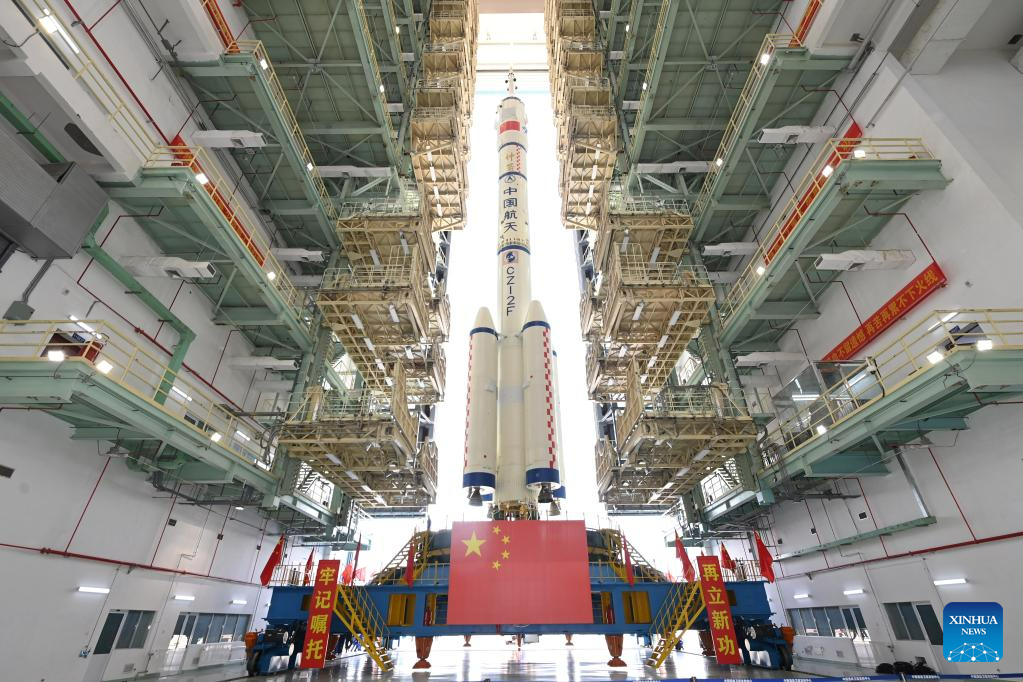
The combination of the Shenzhou-16 crewed spaceship and a Long March-2F carrier rocket is to be transferred to the launching area in Jiuquan Satellite Launch Center in northwest China, May 22, 2023. (Photo by Wang Jiangbo/Xinhua)
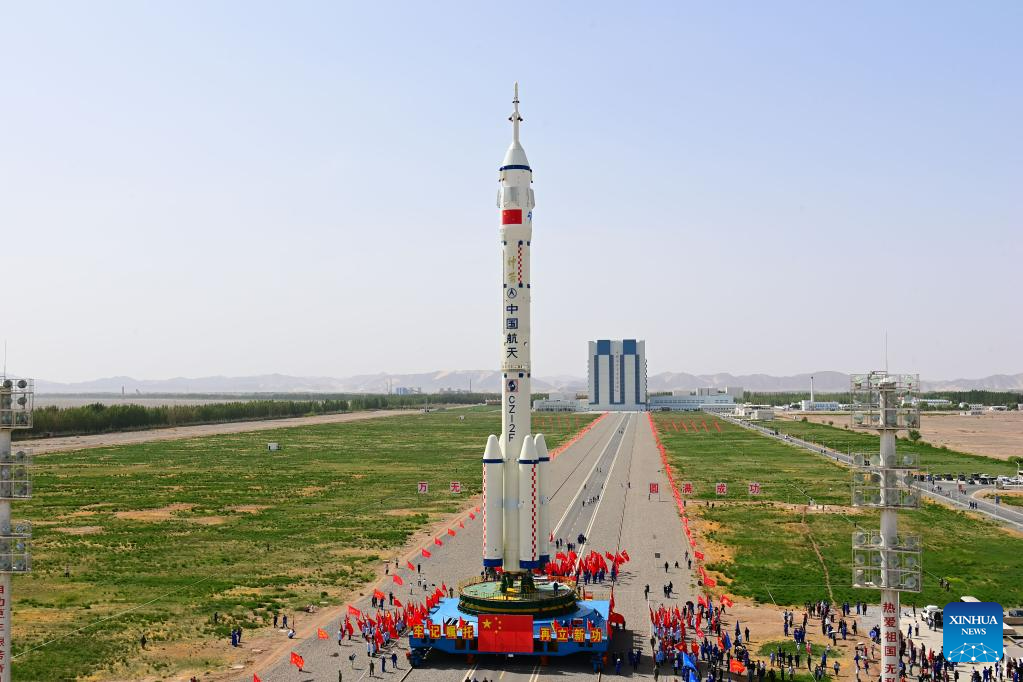
The combination of the Shenzhou-16 crewed spaceship and a Long March-2F carrier rocket was transferred to the launching area on Monday, the China Manned Space Agency (CMSA) said.
The facilities and equipment at the launch site are in good condition, and various pre-launch function checks and joint tests will be carried out as planned, said the CMSA. The spaceship will be launched in the near future at an appropriate time.
Quelle: Xinhua
----
Update: 30.05.2023
.
China Focus: China unveils Shenzhou-16 crew for new space station mission, including first civilian taikonaut
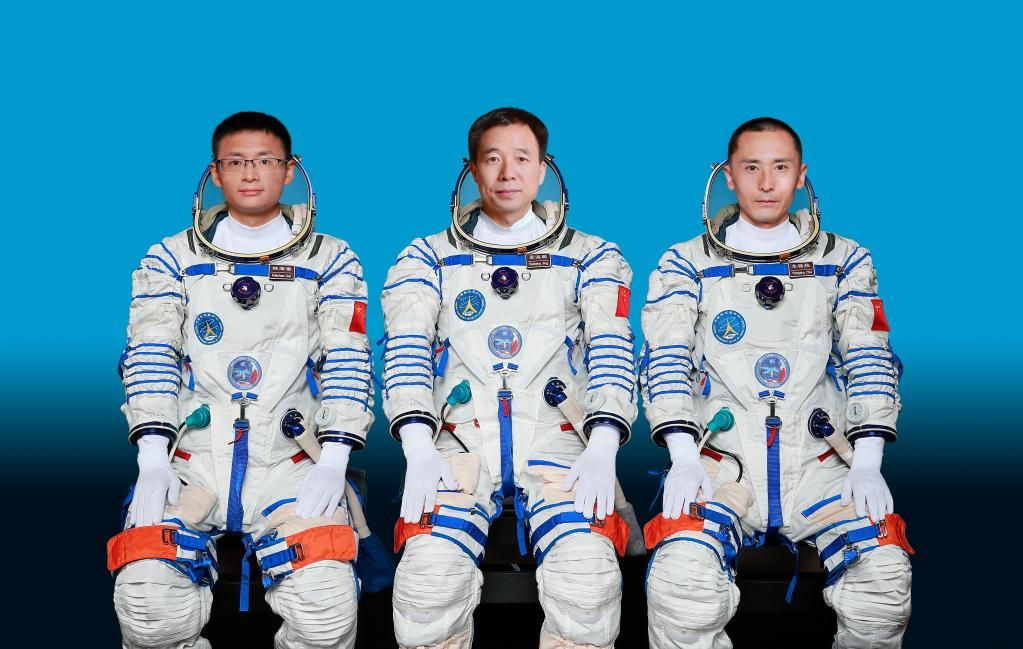
This undated photo shows Chinese taikonauts Jing Haipeng (C), Zhu Yangzhu (R) and Gui Haichao who will carry out the Shenzhou-16 spaceflight mission. Chinese taikonauts Jing Haipeng, Zhu Yangzhu, and Gui Haichao will carry out the Shenzhou-16 spaceflight mission, and Jing will be the commander, the China Manned Space Agency (CMSA) announced at a press conference on May 29, 2023. (Xinhua)
Chinese taikonauts Jing Haipeng, Zhu Yangzhu, and Gui Haichao will carry out the Shenzhou-16 spaceflight mission, and Jing will be the commander, the China Manned Space Agency (CMSA) announced at a press conference on Monday.
Jing, a senior spacecraft pilot, will become the country's first taikonaut to go into space for the fourth time. He was involved in the Shenzhou-7 mission in 2008 and commanded the Shenzhou-9 and Shenzhou-11 crews in 2012 and 2016, respectively.
He has led the new crew in the preparation process. "After more than one year's training together, we have tacit cooperation, understanding each other's every expression, move and look," said Jing.
Zhu and Gui are set to embark on their first trip to space. Born in 1986, they are members of China's third batch of taikonauts, whose selection was completed by September 2020.
A former associate professor at a military university, Zhu will serve as a spaceflight engineer on the Shenzhou-16 mission. He will work with commander Jing to control and manage the spacecraft, and conduct technical tests.
Ahead of the launch of Shenzhou-16, Zhu told the media that he was proud of his career shift and grateful for the new era, which allows hardworking people to have the opportunity to realize their dreams and values in life.
Gui, a spectacled professor at Beijing-based Beihang University, will work as a payload expert, responsible for the in-orbit operations of science experiment payloads in China's Tiangong space station. The 36-year-old taikonaut has rich experience in the fields of science and space engineering.
Addressing the public on Monday, Gui said he felt lucky to become China's first civilian taikonaut in space. He also spoke about how his speciality will contribute to the goals of the upcoming mission.
Compared to previous crews, the Shenzhou-16 comprises a diverse trio of male astronauts from different career backgrounds, including aircraft pilot, flight engineer and payload specialist.
"This is the first crewed mission with the participation of three types of taikonauts," Lin Xiqiang, deputy director of the CMSA, said at the press conference.
Although the fresh crew has a 20-year age gap, the three have worked together very well.
"We have gotten along like a family," said Jing when the trio met the press on Monday.
According to the CMSA, among China's third batch of taikonauts, seven are spacecraft pilots, seven are flight engineers and four are payload experts. After more than two years of rigorous training, they have become capable of performing spaceflight tasks.
"All of them have started targeted training for the space station in the new stage and will become the backbones of the follow-up missions," Lin said, adding that more new members will be selected to be space travelers in the future.
The Shenzhou-16 crewed spaceship will be launched at 9:31 a.m. Tuesday (Beijing Time) from the Jiuquan Satellite Launch Center. It will be the first crew mission after China's space station program entered the stage of application and development.
The three taikonauts will stay in orbit for about five months, conducting large-scale in-orbit experiments and giving space lectures, Lin said.
Quelle: Xinhua
+++
Profile: Jing Haipeng, first Chinese astronaut to enter space four times
Jing Haipeng is about to become the first Chinese astronaut to go into space for a fourth time, as he was selected to be the commander of the upcoming Shenzhou-16 manned space mission.
Jing will spend about five months working with his fellow crewmates Zhu Yangzhu and Gui Haichao in the country's Tiangong space station.
ALWAYS READY TO FLY
Jing Haipeng, born in 1966, has visited space more times than any other Chinese astronaut. Soon, he will break his own record.
"Frankly speaking, I feel quite calm right now. Because as an astronaut, it is our main responsibility to go to space," he said when the crew met the press on Monday.
The veteran astronaut caught the nation's attention in September 2008. He was enlisted as one of three crew members for the Shenzhou-7 mission and travelled in space for more than two days, during which the crew completed China's first space walk.
In June 2012, Jing became the commander of the Shenzhou-9 mission. He worked with Liu Wang and Liu Yang in space for 13 days, completing China's first manned space docking.
In October 2016, Jing was selected as the commander of Shenzhou-11 mission, during which he and Chen Dong spent 33 days in space, laying a solid base for the subsequent construction and operation of the Chinese space station.
With his upcoming five-month stay in space, each of Jing's space trips have lasted longer than the previous one.
NEVER STOP DREAMING
Born in a village in north China's Shanxi Province, Jing first showed an interest in aviation when he was a teenager and found inspiration from a picture of a pilot.
Jing registered for an aviation exam in 1984 but failed the recruitment process due to "physical reasons."
But he did not give up. The following year, he was enrolled with an aviation school. Upon graduation, he was relocated to a training base in Jiangsu Province. He had clocked 1,200 hours of safe flight time while working as a pilot.
After fulfilling his dream of becoming a pilot, Jing gave himself a new target. He wanted to fly even higher and become an astronaut. In 1998, he was selected to be one of China's first astronauts, and was among six candidates trained in 2005 for the Shenzhou-6 mission.
Jing believes that life is made up of different dreams at different stages of time. "We should set up goals one after another, and work hard to realize our dreams."
PERSIST IN PERFECTION
Known for his calm demeanor, Jing is often described by his colleagues as a hard worker, while he admits he is a perfectionist.
For him, there is a world of difference between 99.99 points and 100 when it comes to the manned space career, thus every training program should be completed to the utmost.
In the ten years prior to his first flight, Jing had undergone hundreds of professional skills training courses, such as underwater training simulating weightlessness, hypoxia training, abnormal situation management. He challenged his physiological and psychological limits with amazing perseverance.
"Persist, persist, and persist. There are no shortcuts, and persistence is the only way," he said.
As commander of the Shenzhou-16 mission, which is expected to be launched on Tuesday, Jing is well prepared.
He said 600 push-ups, 600 sit-ups, and jumping ropes have become his daily routine, and he has memorized every word of the flight manuals and operation guides.
He also led the crew in the careful preparation of space science experiments, extravehicular activities, space station maintenance and repair, long-term flight health protection, as well as emergency handling and troubleshooting.
"After more than one year's training together, we have tacit cooperation, understanding each other's every expression, move and look," said the commander.
"We have the determination, confidence and ability to complete this mission," he added.
Quelle: Xinhua
+++
China discloses tasks of Shenzhou-16 manned space
mission
The Shenzhou-16 astronauts will conduct large-scale in-orbit tests and experiments in various fields as planned, announced a senior official from the China Manned Space Agency (CMSA) at a press conference on Monday.
They are expected to make high-level scientific achievements in the study of novel quantum phenomena, high-precision space time-frequency systems, the verification of general relativity, and the origin of life, said Lin Xiqiang, deputy director of the CMSA.
The Shenzhou-16 mission will also install electric propulsion cylinders and lift extravehicular cameras, Lin said.
In addition, this mission will complete the installation of large extravehicular application facilities such as radiation biological exposure experiment equipment, he said.
The Shenzhou-16 crew, consisting of Jing Haipeng, Zhu Yangzhu and Gui Haichao, will witness the dockings of the Tianzhou-5 cargo craft and the Shenzhou-17 crewed spaceship, as well as the departures of the Shenzhou-15 manned spaceship and Tianzhou-5, he said.
The astronauts will also deliver space lectures during their mission.
China's space station has entered the stage of application and development. Work handovers of different groups of astronauts and cargo supply missions will be implemented regularly in the following missions.
According to Lin, the in-orbit work of astronauts mainly covers six categories.
The first is to operate the dockings and returns of crewed spaceships and assist in the dockings and departures of cargo craft and survey telescopes, ensuring regular personnel rotation and material supply.
The second is the maintenance of the space station complex, including the spacecraft status setting, in-orbit material management, platform equipment maintenance and inspection, equipment installation inside and outside the modules, and payload entry into and exit from the modules.
The third is the health management of astronauts, including health status monitoring and in-orbit exercise and training.
The fourth is to conduct large-scale in-orbit scientific research and applications.
The fifth is the popularization of science, such as giving space lectures and shooting videos for public service.
The sixth aspect involves handling in-orbit failures, fixing and replacing faulty equipment, and conducting extravehicular maintenance when necessary to ensure long-term stable operation of the space station.
Lin said large-scale space science and technology experiments will be carried out in the following flight missions, including almost 1,000 scientific research and application projects in four fields, namely space life science and human body research, microgravity physics science, space astronomy and Earth science, and new space technology and application.
The CMSA will release the solicitation details and guidelines for scientific and application projects for the application and the development stage of the country's space station to achieve full operation of the space station application resources and higher-quality application outcomes.
China will develop a new generation reusable near-Earth manned carrier rocket and near-Earth manned spaceship, Lin said.
The country will launch an extension module at an appropriate time and expand the basic configuration of the space station from the current T shape to a cross shape to further support the in-orbit scientific experiments and create better working and living conditions for astronauts.
Quelle: Xinhua
+++
China to launch Shenzhou-16 crewed spaceship on May 30
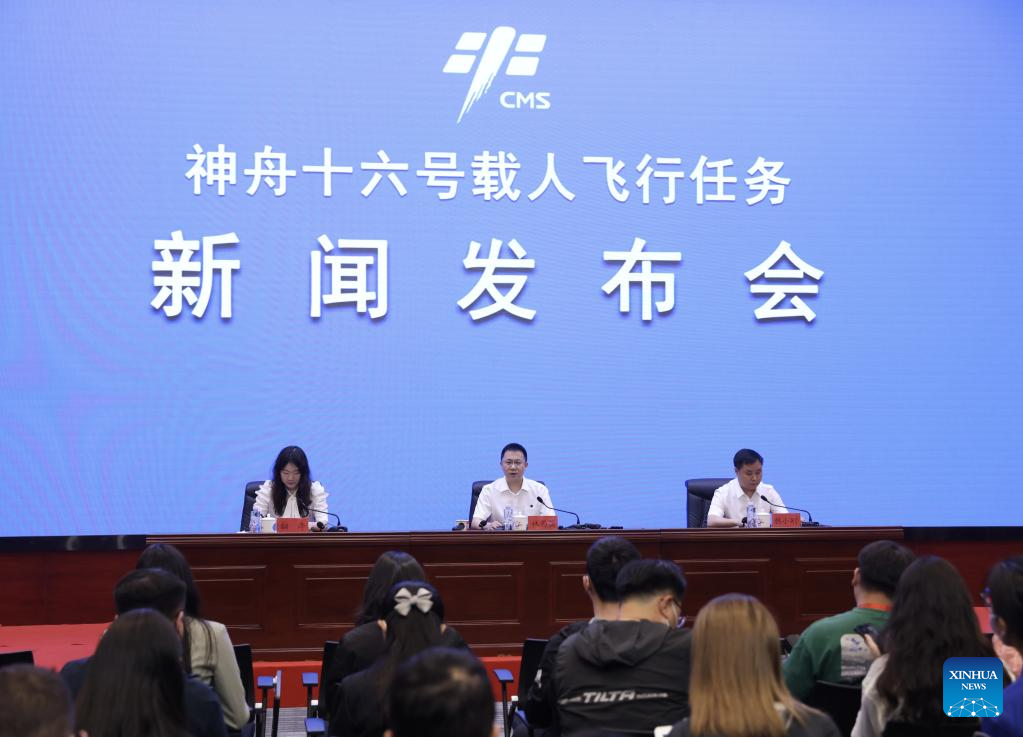
A press conference is held in Jiuquan Satellite Launch Center in northwest China on May 29, 2023. Chinese taikonauts Jing Haipeng, Zhu Yangzhu and Gui Haichao will carry out the Shenzhou-16 spaceflight mission, and Jing will be the commander, the China Manned Space Agency announced at the press conference on Monday. (Xinhua/Jin Liwang)
The Shenzhou-16 crewed spaceship is scheduled to be launched at 9:31 a.m. Tuesday (Beijing Time) from the Jiuquan Satellite Launch Center in northwest China, announced the China Manned Space Agency (CMSA) on Monday.
The spaceship will carry three astronauts -- Jing Haipeng, Zhu Yangzhu and Gui Haichao -- to carry out the Shenzhou-16 spaceflight mission. Jing will be the commander, said Lin Xiqiang, deputy director of the CMSA, at a press conference.
Shenzhou-16 is the second flight mission of China's manned space program this year, and the first crewed mission after China's space station entered the application and development stage.
The launch will use a Long March-2F carrier rocket, which will be filled with propellant soon, Lin said.
After entering orbit, the spaceship will perform a fast automated rendezvous and docking with the radial port of the space station core module Tianhe, forming a combination with three modules and three spacecraft, Lin said.
The Shenzhou-16 crew will stay in orbit for about five months, and will return to the Dongfeng landing site in north China's Inner Mongolia Autonomous Region in November this year.
During their stay, they will witness the arrival of the Shenzhou-17 crewed spaceship, he said.
The space station combination is now in a stable status with all equipment functioning well. Product qualities of the Shenzhou-16 spaceship and the Long March-2F carrier rocket are under control, Lin said.
The Shenzhou-16 crew is in good condition, while the ground system facilities are in stable operation, Lin said.
All preparations for the launch have been completed, he added.
Quelle: Xinhua
+++
Chinese astronaut launch breaks record for most people in orbit

A Long March 2F rocket climbs through the sky after lifting off from the Jiuquan launch base with the Shenzhou 16 astronauts. Credit: China Manned Space Agency
The launch of the next crew to China’s Tiangong space station late Monday (U.S. time) added three astronauts to the population of humans in space, which reached a record number of 17 people in orbit — six Chinese citizens, five Americans, three Russians, two Saudis, and one Emirati astronaut.
The arrival of Chinese astronauts Jing Haipeng, Zhu Yangzhu, and Gai Haichao in space following their launch atop a Long March rocket broke the previous record of 14 people in orbit at one time.
The three-man crew climbed into their seats inside the Shenzhou 16 spacecraft a few hours before liftoff at the Jiuquan launch base, a military-run facility in the Gobi Desert of northwestern China. After ground teams moved a safe distance away from the launch pad, the Long March 2F rocket lit its hydrazine-fueled engines at 9:31:10 p.m. EDT Monday (0131:10 UTC; 9:31:10 a.m. Beijing time Tuesday).
A few moments later, the 191-foot-tall (58-meter) rocket climbed away from its launch pad and headed east, lining up with the flight path of the Tiangong space station.
The Long March 2F shed its four strap-on boosters and first stage about two-and-a-half minutes into the mission. A second stage engine ignited to accelerate the Shenzhou 16 spacecraft into orbit, before deploying the crew capsule about 10 minutes after liftoff.
Jing, the first Chinese astronauts to fly to space four times, monitored cockpit displays with his two crewmates throughout the automated ascent into orbit.
Shenzhou 16 extended its power-generating solar panels a few minutes after the spacecraft separated from its launch vehicle. Ground teams declared the launch a success, a smooth start to China’s 11th human spaceflight mission, and the fifth to the Tiangong space station.
The three astronauts on the Shenzhou 16 spacecraft were scheduled to dock with the Tianhe core module at the Tiangong space station Tuesday, temporarily bringing the crew of the 100-metric ton Chinese space lab to six. The three Chinese astronauts who have lived and worked on the Tiangong space station since November are slated to depart in their Shenzhou 15 crew capsule Saturday to head for re-entry and landing in China.
The six Chinese astronauts aboard or en route to the Tiangong space station are joined in space by 11 crew members on the International Space Station, which normally has a long-duration complement of seven astronauts and cosmonauts. There are four additional private astronauts on the International Space Station for an eight-day stay slated to end Tuesday.
The four commercial astronauts — two Americans and two Saudis — flew to the ISS on a SpaceX Crew Dragon spacecraft on a private astronaut mission managed by Axiom Space. The Axiom crew is set to return to Earth on Tuesday night, targeting a parachute-assisted splashdown in the Gulf of Mexico.
Chinese officials revealed the identities of the astronauts on the Shenzhou 16 mission Monday, about 24 hours prior to the scheduled launch time. In contrast to the U.S. and Russian space programs, China typically keeps its crew assignments secret until the day before launch.
The crew is commanded by Jing Haipeng, 56, a major general in China’s military and a former fighter pilot in the Chinese Air Force. Jing, who joined China’s astronaut corps in the first group selected in 1998, became the first Chinese astronaut to launch on four space missions, following previous flights in 2008, 2012, and 2016.
In a press conference Monday, Jing said he has studied and memorized more than 70 flight manuals and thousands of operating instructions. He logged 47 days in orbit on his three previous missions.
“At this moment, to be honest, I feel very peaceful because, as an astronaut, going to space is our main responsibility and main business, and winning glory for the country is our … mission,” Jing said in translated remarks.
The three-man Shenzhou 16 crew will replace the Shenzhou 15 astronauts, who launched Nov. 29 and are now wrapping up a half-year in orbit. Shenzhou 15 commander Fei Junlong and astronauts Deng Qingming and Zhang Lu took the place of the Shenzhou 14 crew.
Two spaceflight rookies joined Jing on the six-month Shenzhou 16 expedition on China’s Tiangong space station.
Zhu Yangzhu, another Chinese pilot and military officer, will serve as spaceflight engineer. Gui Haichao is a payload specialist on the Shenzhou 16 mission, and will become the first civilian astronaut to fly in China’s human spaceflight program. Both are 36 years old.
“As an aerospace flight engineer, under the leadership of the commander, I will complete the daily maintenance, maintenance and repair tasks of the space station assembly, carry out load care and actual tests, and ensure that the space station can be safe, stable, efficient and long-lasting,” Zhu said Monday.
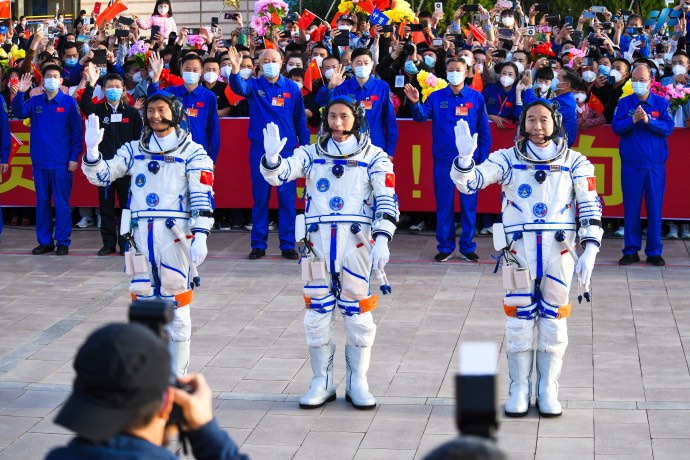
Gui will be responsible for overseeing the scientific experiments on the Tiangong space station, which consists of the Tianhe core module and two attached pressurized lab modules. China completed the initial assembly of the Tiangong space station last year. The Chinese space complex — about a third the size of the International Space Station — is transitioning from construction to a new phase of scientific utilization expected to last more than 10 years.
China launched an piloted cargo ship to the Tiangong space station earlier this month to deliver food, supplies, experiments, and other hardware for use by the Shenzhou 16 crew.
“This mission is the first manned flight to the Chinese space station after it entered a new stage of application and development,” Jing said. “As you can see today, a brand new (crew) combination also made its debut. Our crew is composed of the pilot, the first aerospace engineer and the first payload expert, which also means that we will undertake more complex, arduous and arduous tasks.”
The tasks awaiting the Shenzhou 16 astronauts include overseeing the safety and maintenance of the Tiangong space station, and performing “large-scale scientific research” experiments, said Lin Xiqiang, deputy director of the China Manned Space Engineering Office.
The astronauts will also connect virtually with Chinese students for classroom lessons and outreach events.
Jing and his crewmates on the Shenzhou 16 mission will also head outside the Tiangong space station for spacewalks to service the lab’s electric propulsion system, install a camera and a radiation biological exposure experiment. The scientific program for the Shenzhou 16 mission includes investigations into quantum phenomena, general relativity, and the origin of life, Chinese space officials said.
Overall, China’s Manned Space Agency says the Tiangong space station over its lifetime will support nearly 1,000 scientific research and application projects in human physiology, microgravity physical science, astronomy, Earth science, and technology demonstrations.
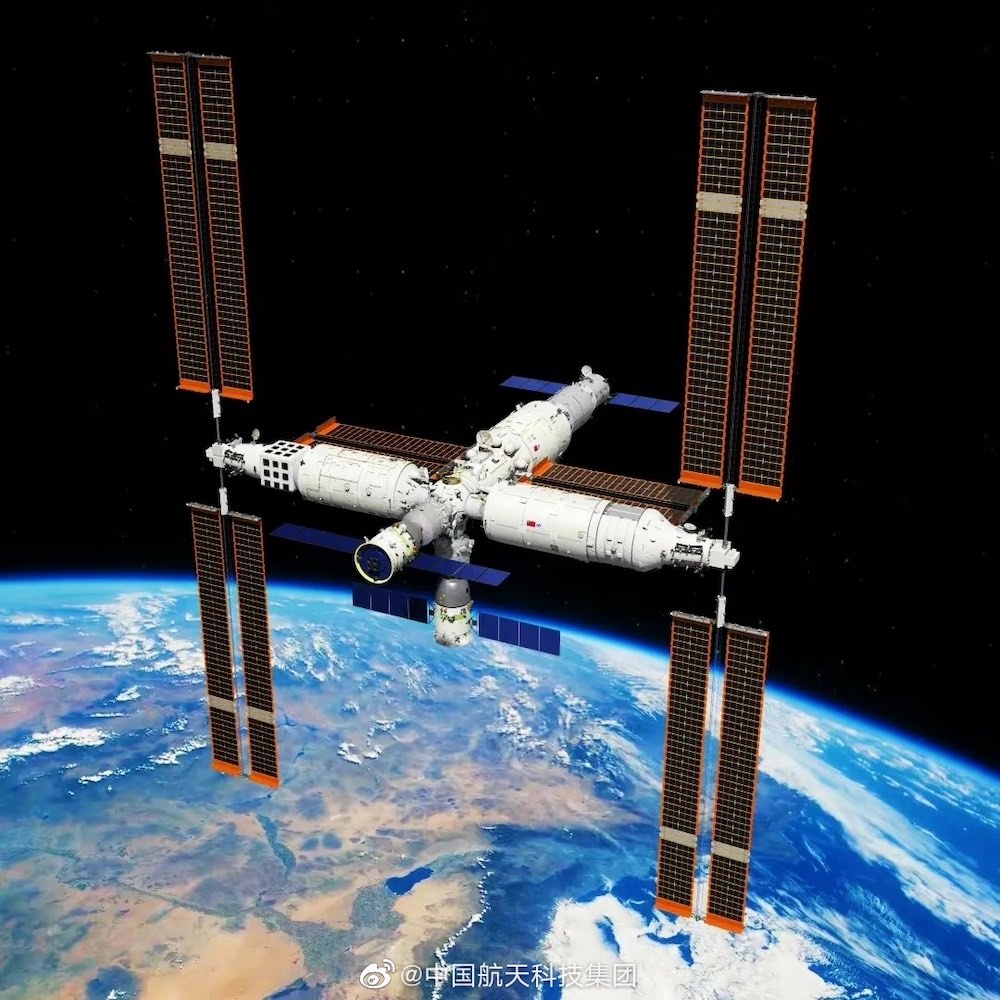
Chinese space officials are also planning to build and launch an expansion module to add to the pressurized volume of the Tiangong space station. Earlier this month, China announced a call for proposals from Chinese industry for a commercial cargo transportation system to resupply the Tiangong station, similar to NASA’s Commercial Resupply Services program that fostered development of SpaceX’s Dragon and Northrop Grumman’s Cygnus cargo vehicles.
China also plans to launch an optical telescope next year that will periodically dock with the Tiangong space station for servicing.
Quelle: SN
+++
China launches Shenzhou-16 manned spaceship for 5-month intensive tasks in space station
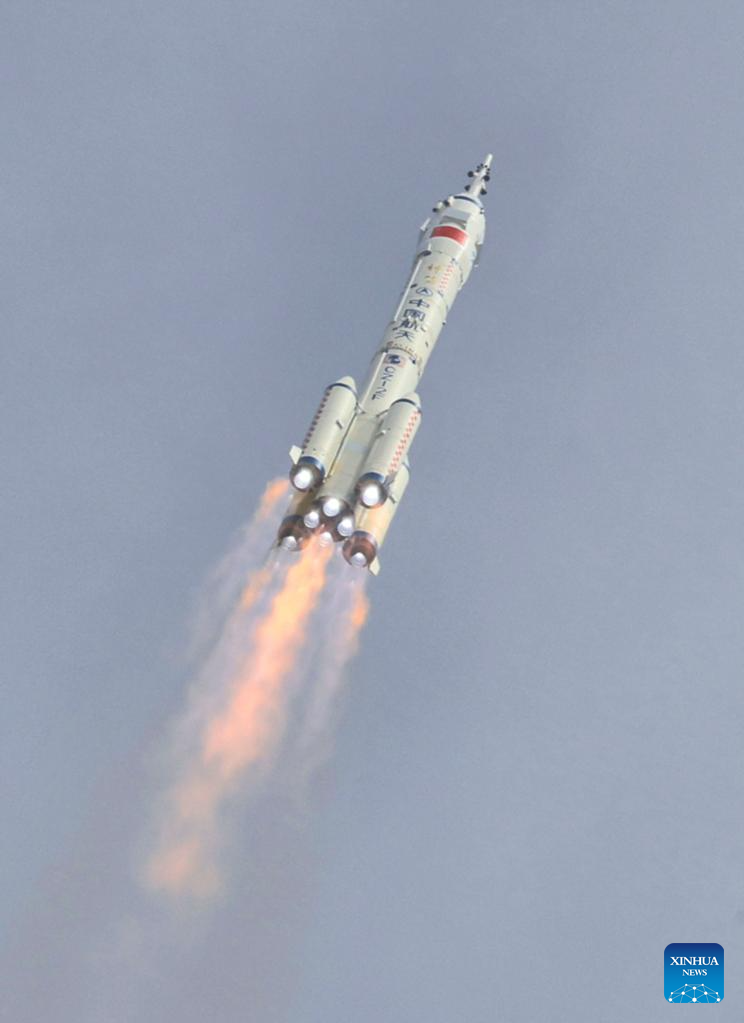
China on Tuesday launched the Shenzhou-16 manned spaceship, sending three astronauts to its space station combination for a five-month mission.
The spaceship, atop a Long March-2F carrier rocket, blasted off from the Jiuquan Satellite Launch Center in northwest China at 9:31 a.m. (Beijing Time), according to the China Manned Space Agency (CMSA).
About 10 minutes after the launch, Shenzhou-16 separated from the rocket and entered its designated orbit. The crew members are in good shape and the launch is a complete success, the CMSA declared.
After entering orbit, the Shenzhou-16 spaceship will make a fast, automated rendezvous and docking with the space station combination. The Shenzhou-16 crew will rotate with the Shenzhou-15 crew in orbit.
The Shenzhou-16 astronauts will conduct large-scale in-orbit tests and experiments in various fields as planned. They are expected to make high-level scientific achievements in the study of novel quantum phenomena, high-precision space time-frequency systems, the verification of general relativity, and the origin of life.
The crew, consisting of Jing Haipeng, Zhu Yangzhu and Gui Haichao, will witness the dockings of the Tianzhou-5 cargo craft and the Shenzhou-17 manned spaceship, as well as the departures of the Shenzhou-15 manned spaceship and Tianzhou-5.
It is the first crewed mission for the application and development stage of China's space station, and the 29th flight mission since the country's manned space program was approved and initiated.
The launch also marks the 475th flight mission of the Long March carrier rocket series.
The space station combination is now in orbit for the rendezvous and docking. It is in good working condition and ready for the rendezvous-and-docking of Shenzhou-16 and the entering of its crew.
Quelle: Xinhua
+++
China's Shenzhou-16 crewed spaceship docks with space station combination
China's Shenzhou-16 crewed spaceship successfully docked with the space station combination on Tuesday, according to the China Manned Space Agency.
Quelle: Xinhua
----
Update: 1.06.2023
.
Shenzhou-16 crew enter space station, complete handover in five days
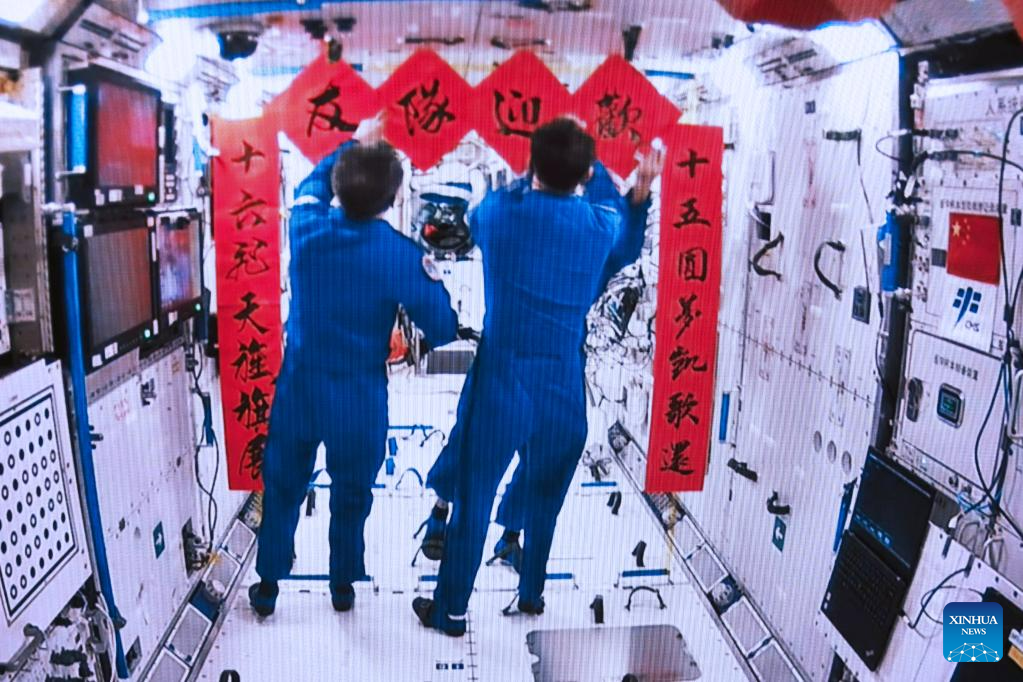
This screen image captured at Beijing Aerospace Control Center on May 30, 2023 shows the Shenzhou-15 crew putting up couplets to welcome the Shenzhou-16 crew inside the core module Tianhe of China's space station. (Xinhua/Li Jie)
The three astronauts aboard China's Shenzhou-16 spaceship entered the country's space station and met with another astronaut trio on Tuesday, starting a new round of in-orbit crew handover.
The Shenzhou-15 crew opened the hatch at 6:22 p.m. (Beijing Time). The three space station occupants greeted the new arrivals, and they took group pictures.
The space get-together kicked off the second in-orbit crew rotation in China's space station.
According to the China Manned Space Agency, the six astronauts will live and work together for about five days to complete planned tasks and handover work.
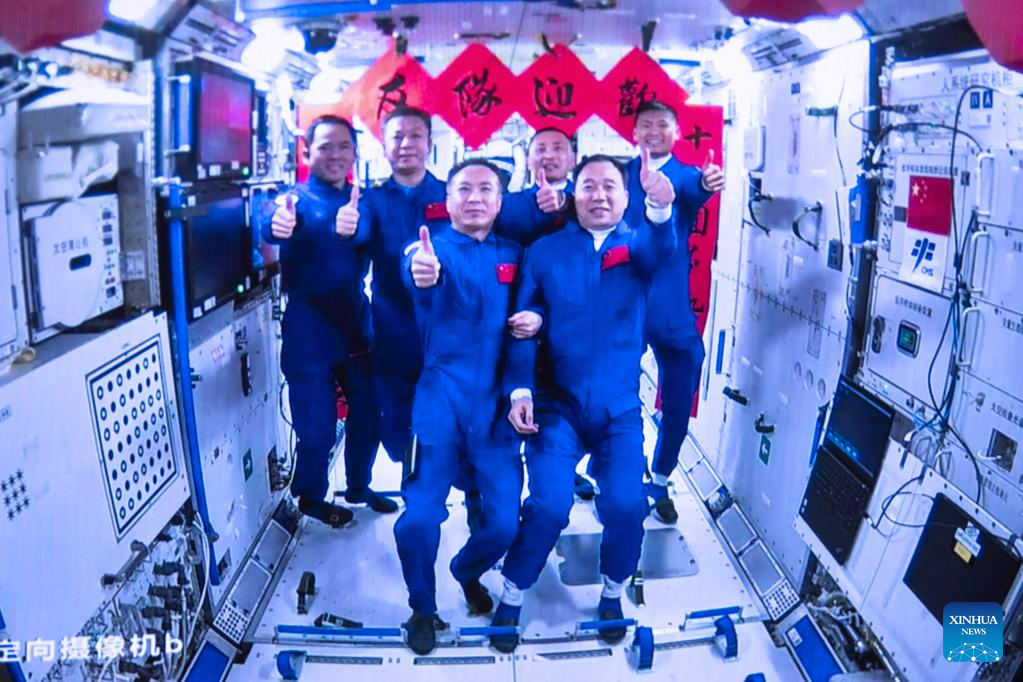
This screen image captured at Beijing Aerospace Control Center on May 30, 2023 shows the Shenzhou-15 and Shenzhou-16 crew taking group pictures inside the core module Tianhe of China's space station. (Photo by Han Qiyang/Xinhua)
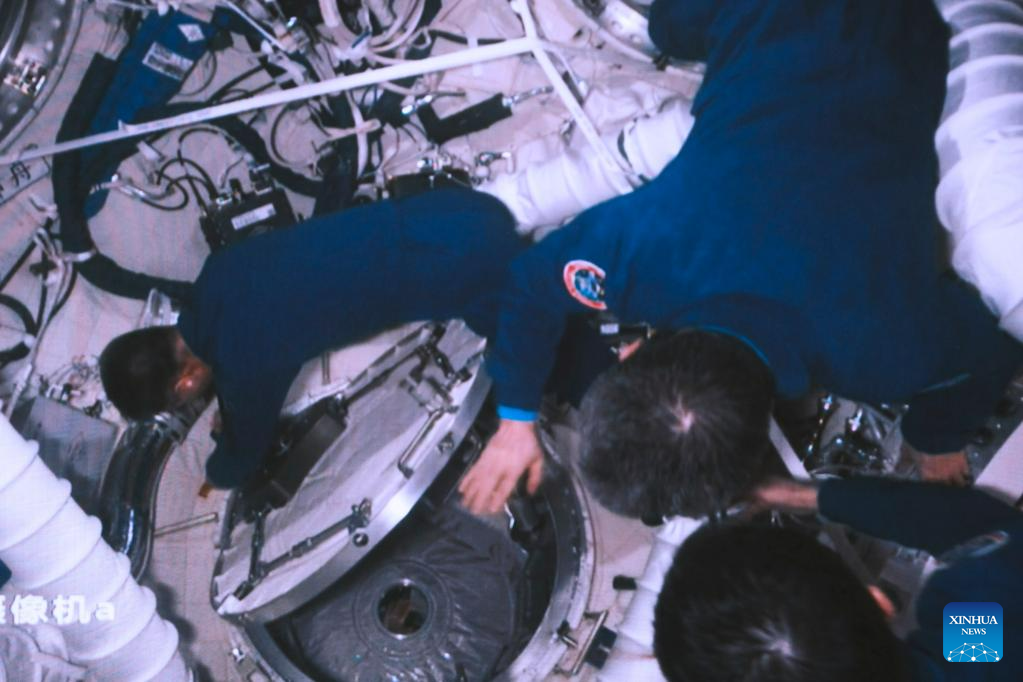
This screen image captured at Beijing Aerospace Control Center on May 30, 2023 shows the Shenzhou-15 crew waving to the Shenzhou-16 crew from the core module Tianhe of China's space station. (Xinhua/Li Jie)
Quelle: Xinhua
